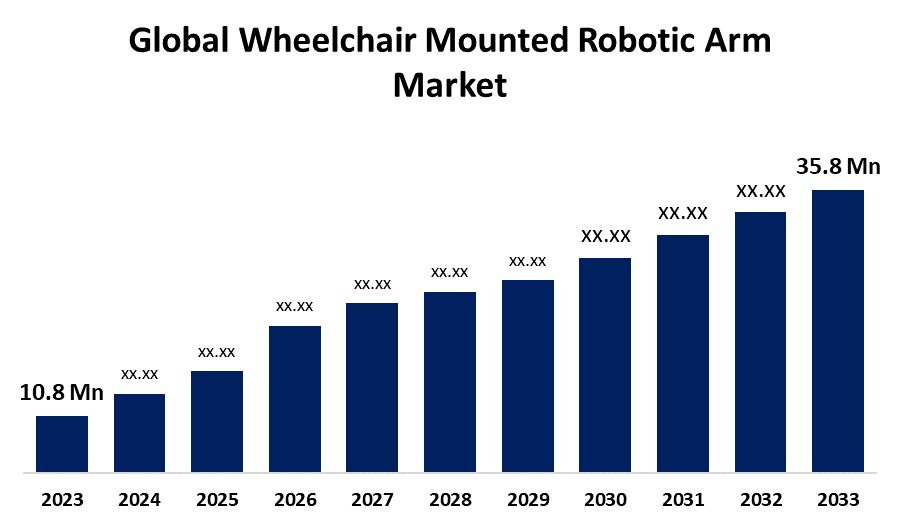Global Wheelchair Mounted Robotic Arm Market Size, Share, and COVID-19 Impact Analysis, By Device Type (Articulated Arm, Selective Compliance Assembly Robot Arm (SCARA), Parallel Robots), By Application (Spinal Cord Injury, Neurological Condition, Others), By End-User (Hospitals, Clinics, Rehabilitation Centers, Others), and By Region (North America, Europe, Asia-Pacific, Latin America, Middle East, and Africa), Analysis and Forecast 2023 – 2033.
Industry: HealthcareGlobal Wheelchair Mounted Robotic Arm Market Insights Forecasts to 2033.
- The Global Wheelchair Mounted Robotic Arm Market Size was Valued at USD 10.8 Million in 2023.
- The Market Size is Growing at a CAGR of 12.73% from 2023 to 2033.
- The Worldwide Global Wheelchair Mounted Robotic Arm Market Size is Expected to Reach USD 35.8 Million by 2033.
- Europe is Expected to Grow the fastest during the forecast period.

Get more details on this report -
The Global Wheelchair Mounted Robotic Arm Market Size is Anticipated to Exceed USD 35.8 Million by 2033, Growing at a CAGR of 12.73% from 2023 to 2033.
Market Overview
A Global Wheelchair-mounted robotic arm is a mechanical device that is fastened to a global wheelchair to enable individuals with mobility disabilities to interact with their surroundings, operate items, and carry out different jobs. Depending on the level of technological sophistication, these robotic arms are operated by a combination of specialized interfaces including buttons, joysticks, or brain-computer interfaces. The rate at which products are adopted has increased due to technological developments in sensor technologies, actuators, materials, and control systems. More sophisticated robotic arms are easier to use, more versatile, and more precise. Incorporating technologies like as voice commands, gesture recognition, and brain-computer interfaces is necessary to develop control interfaces that are both intuitive and efficient. The user and the robotic arm might interact more effectively and naturally because of this. Global awareness of assistive and rehabilitative robots is driving the wheelchair-mounted robotic arms market's expected expansion outside conventional markets. Developed economies and areas with expanding healthcare systems are emerging as key markets for these gadgets.
Report Coverage
This research report categorizes the market for the global wheelchair-mounted robotic arm market based on various segments and regions forecasts revenue growth and analyzes trends in each submarket. The report analyses the key growth drivers, opportunities, and challenges influencing the global wheelchair-mounted robotic arm market. Recent market developments and competitive strategies such as expansion, product launch, and development, partnership, merger, and acquisition have been included to draw the competitive landscape in the market. The report strategically identifies and profiles the key market players and analyses their core competencies in each sub-segment of the global wheelchair robotic arm market.
Global Wheelchair Mounted Robotic Arm Market Report Coverage
| Report Coverage | Details |
|---|---|
| Base Year: | 2023 |
| Market Size in 2023: | USD 10.8 Million |
| Forecast Period: | 2023-2033 |
| Forecast Period CAGR 2023-2033 : | 12.73% |
| 2033 Value Projection: | USD 35.8 Million |
| Historical Data for: | 2019-2022 |
| No. of Pages: | 200 |
| Tables, Charts & Figures: | 110 |
| Segments covered: | By Device Type, By Application, By End-User, By Region |
| Companies covered:: | Sunrise Medical LLC, WHILL Inc, Permobil, MEYRA GmbH, Matia Robotics, Inc., Karman Healthcare, Inc., UPnRIDE Robotics Ltd., Ottobock, Centaur Robotics., tmsuk co., ltd (Rodem), Nino Robotics., Kinova Inc., Cyberworks Robotics, and Others Key Vendors |
| Pitfalls & Challenges: | Covid-19 Empact, Challenges, Growth, Analysis. |
Get more details on this report -
Driving Factors
The use of assistive technology provides wider socioeconomic benefits and can benefit an individual's family, friends, and community. For example, early hearing aid supply minimizes negative consequences on children's schooling, future employment, and community involvement while assisting young children in developing their language and communication skills. The availability of suitable global wheelchairs promotes mobility, increases individuals' access to work and education, and lowers healthcare expenses since fewer individuals develop secondary issues including contractures and pressure sores. Global wheelchair-mounted robotic systems heavily rely on assistive technology since it makes a variety of activities of daily living (ADL) easier and more autonomous for individuals with impairments. In addition, the market for global wheelchair-mounted robotic arms is expected to grow due to several other factors, including the growing emphasis on independence and rehabilitation as means of enhancing quality of life, growing public awareness of and support for global wheelchair-mounted robotic devices, and more.
Restraining Factors
The primary obstacle impeding the growth of the electric global wheelchair industry is its high cost, which makes it unaffordable for many facilities, including small hospitals and clinics. Therefore, this issue must be addressed. The greatest challenge facing the robotic wheelchair market globally is expected to be people's inclination towards low-cost, low-maintenance solutions. Even with the benefits of reimbursement, things like product recalls and technical issues could prevent this industry from expanding.
Market Segmentation
The global wheelchair robotic arm market share is classified into device type, application, and end-use.
- The articulated segment is expected to hold the largest share of the global wheelchair robotic arm market during the forecast period.
Based on the device type, the global wheelchair-mounted robotic arm market is divided into the articulated arm, selective compliance assembly robot arms (SCARA), and parallel robots. Among these articulated arms segments is expected to hold the largest share of the global wheelchair robotic arm market during the forecast period. This is attributed to a key component of global wheelchair-mounted robotic systems is the articulated arm, such as the Jaco robotic arm. These robotic arms are intended to improve the freedom of individuals whose arm function is either limited or nonexistent by helping them with a variety of chores. The FDA's approval of new devices, company launches, and other factors all contribute to the segment's growth over the projection period. For example, the Jaco robotic arm is a lightweight, safe gadget that enables individuals to accomplish tasks like eating, opening doors, and picking up objects with three fingers. It can be included in a motorized global wheelchair so that users can operate it with the controller that comes with the global wheelchair.
- The neurological condition segment is expected to hold the largest share of the global wheelchair robotic arm market during the forecast period.
Based on the application, the global wheelchair-mounted robotic arm market is divided into spinal cord injury, neurological conditions, and others. Among these, neurological conditions the segment is expected to hold the largest share of the global wheelchair-mounted robotic arm market during the forecast period. This is attributed to mobility problems, and robotic arms fitted on global wheelchairs can provide those with these conditions with invaluable support. Different neurological disorders can cause different degrees of impairment to mobility, such as cerebral palsy, multiple sclerosis, and amyotrophic lateral sclerosis (ALS). By helping with mobility, robotic arms attached to global wheelchairs allow users to reclaim a certain level of freedom.
- The hospital segment is expected to hold the largest share of the global wheelchair-mounted robotic arm market during the forecast period.
Based on the end use, the global wheelchair-mounted robotic is divided into hospitals, clinics, rehabilitation centers, and others. Among these, hospitals are expected to hold the largest share of the global wheelchair-mounted robotic market during the forecast period. This is attributed to enhancing the current surgical interventions, such as orthopedic and minimally invasive procedures.
Regional Segment Analysis of the global wheelchair mounted robotic arm market
- North America (U.S., Canada, Mexico)
- Europe (Global, France, U.K., Italy, Spain, Rest of Europe)
- Asia-Pacific (China, Japan, India, Rest of APAC)
- South America (Brazil and the Rest of South America)
- The Middle East and Africa (UAE, South Africa, Rest of MEA)
North America is anticipated to hold the largest share of the global wheelchair robotic arm market over the predicted timeframe.

Get more details on this report -
North America is anticipated to hold the largest share of the global wheelchair robotic arm market over the predicted timeframe. Due to the region's expanding disposable income, growing healthcare costs, a growing number of disabled individuals, and other variables. Furthermore, it is projected that growing rates of neurological conditions including multiple sclerosis, stroke, traumatic brain injuries, etc. will increase demand for the products.
Europe is expected to grow the fastest during the forecast period. The industry's expansion is ascribed to the number of participants in the nation as well as rising R&D spending to meet customer demands. Major industry firms are heavily represented in the area, which promotes innovation and market expansion. Furthermore, a rise in research endeavors adds to the region's prominence in the progression of robotic arm technology.
Competitive Analysis:
The report offers the appropriate analysis of the key organizations/companies involved within the global wheelchair-mounted robotic arm market along with a comparative evaluation primarily based on their product offering, business overviews, geographic presence, enterprise strategies, segment market share, and SWOT analysis. The report also provides an elaborative analysis focusing on the current news and developments of the companies, which includes product development, innovations, joint ventures, partnerships, mergers & acquisitions, strategic alliances, and others. This allows for the evaluation of the overall competition within the market.
List of Key Companies
- Sunrise Medical LLC
- WHILL Inc
- Permobil
- MEYRA GmbH
- Matia Robotics, Inc.
- Karman Healthcare, Inc.
- UPnRIDE Robotics Ltd.
- Ottobock
- Centaur Robotics.
- tmsuk co., ltd (Rodem)
- Nino Robotics.
- Kinova Inc.
- Cyberworks Robotics
Key Target Audience
- Market Players
- Investors
- End-users
- Government Authorities
- Consulting and Research Firm
- Venture capitalists
- Value-Added Resellers (VARs)
Recent Development
- In September 2022, Kinova established a strategic alliance with Formant, a cutting-edge robotics startup that offers robotics platforms. The goal of this collaboration was to develop cutting-edge robotic arms that would facilitate the increasing usage of assistive technologies in many nations throughout the world. The company was able to grow its customer base and improve its R&D skills because of this strategic alliance.
- In February 2020, to broaden its clientele, Numotion, a provider of complex rehab technology (CRT) services, purchased Monroe Global Wheelchair, a business that offered medical and CRT equipment services.
Market Segment
This study forecasts revenue at regional, and country levels from 2022 to 2033. Spherical Insights has segmented the global wheelchair-mounted robotic arm market based on the below-mentioned segments:
Global Wheelchair Mounted Robotic Arm Market, By Device Type
- Articulated Arm
- Selective Compliance Assembly Robot Arm (SCARA)
- Parallel Robots
Global Wheelchair Mounted Robotic Arm Market, By Application
- Spinal Cord Injury
- Neurological Condition
- Others
Global Wheelchair Mounted Robotic Arm Market, By End-user
- Hospitals
- Clinics
- Rehabilitation Centers
- Others
Global Wheelchair Mounted Robotic Arm Market, By Region
- North America
- US
- Canada
- Mexico
- Europe
- Germany
- UK
- France
- Italy
- Spain
- Russia
- Rest of Europe
- Asia Pacific
- China
- Japan
- India
- South Korea
- Australia
- Rest of Asia Pacific
- South America
- Brazil
- Argentina
- Rest of South America
- Middle East & Africa
- UAE
- Saudi Arabia
- Qatar
- South Africa
- Rest of the Middle East & Africa
Need help to buy this report?